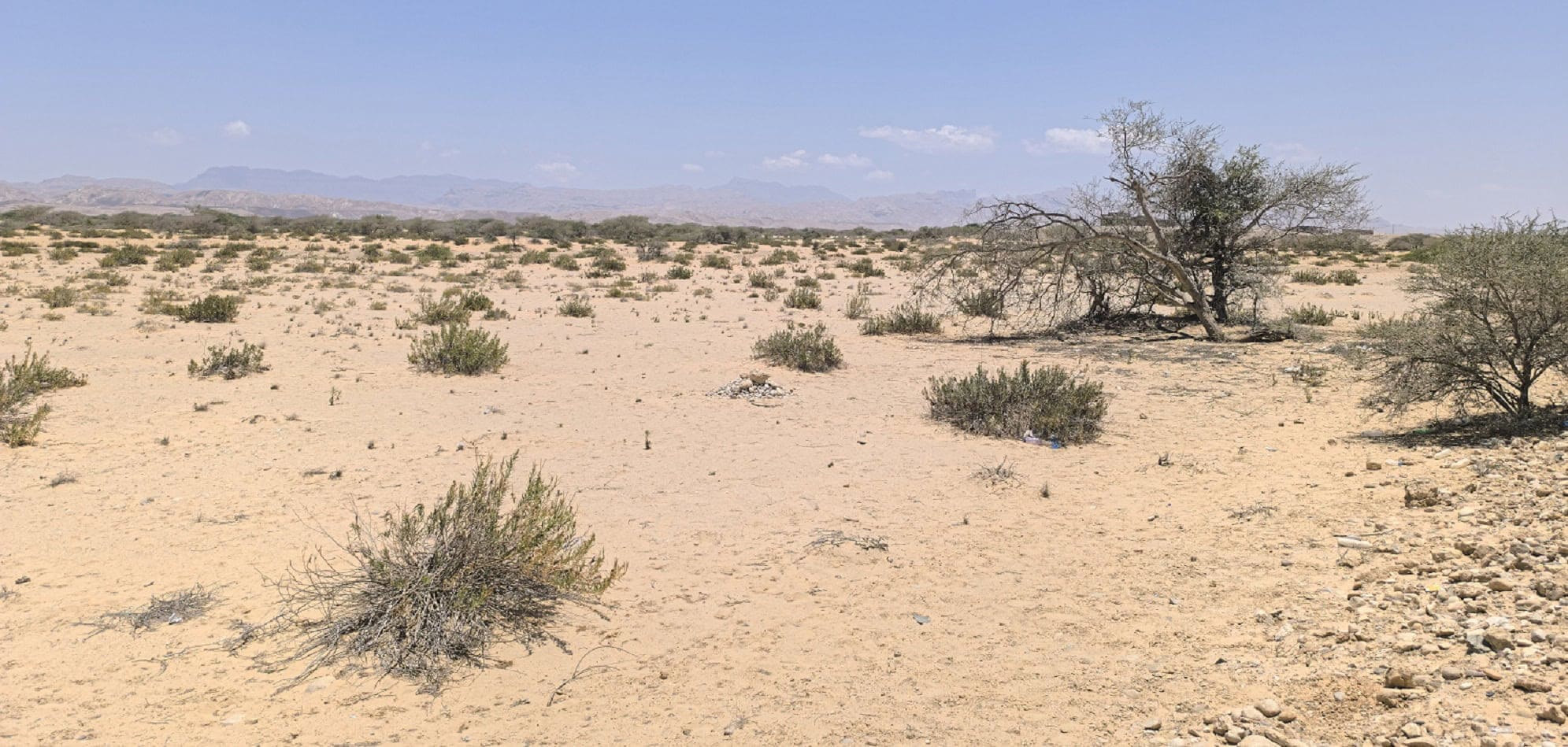
The effects of desertification in Habban, Shabwa governorate, South Yemen, May 1, 2025 (South24 Center)
Last updated on: 25-06-2025 at 3 PM Aden Time

|
|
Abdullah Al-Shadli (South24)
In a country exhausted by war and where life’s necessities have dwindled, desertification is swallowing green spaces, turning them into barren lands. Desertification has expanded slowly but steadily, driven by a combination of climatic and human factors. Amid the ongoing armed conflict, and the depletion of resources as well as the absence of environmental policies, this environmental threat appears to have found a clear path to spread deep into Yemen’s geography, which is considered one of the most vulnerable regions in the world affected by climate change.
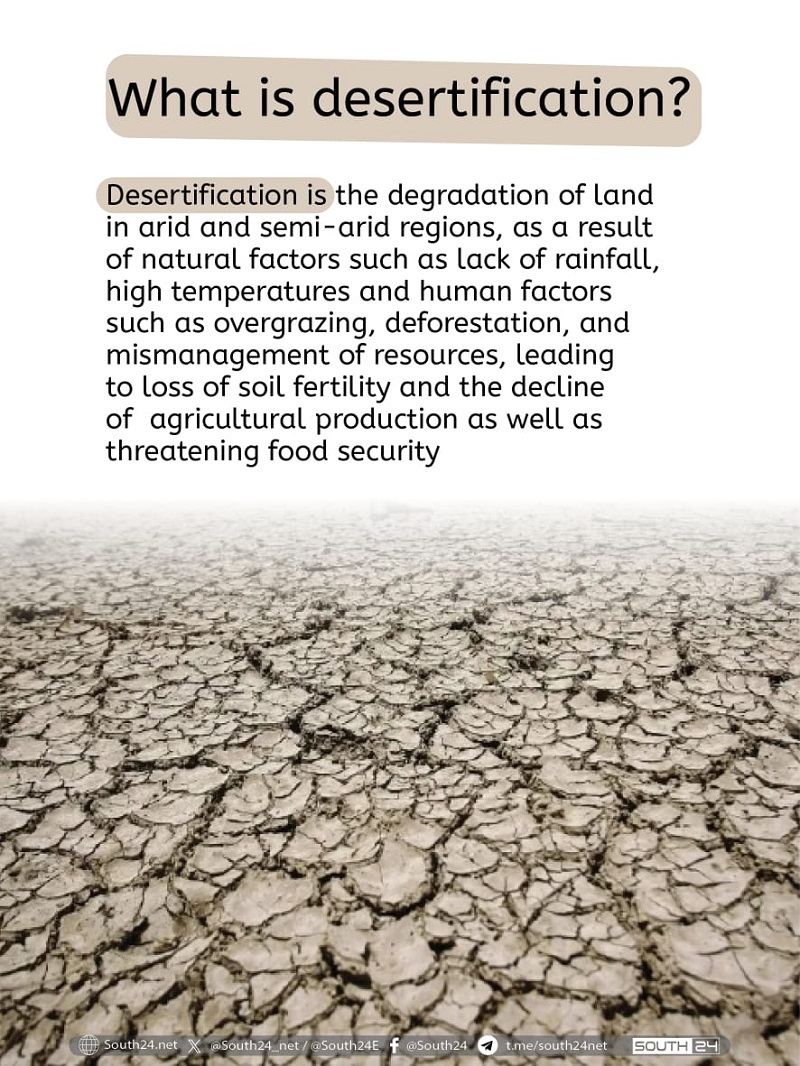
Climate shifts in Yemen, including rising temperatures, irregular rainfall, and the increased severity of natural disasters, such as floods and hurricanes, have created a fertile ground for worsening of the desertification crisis. Alongside these climatic factors, unsustainable human activities such as excessive deforestation, overgrazing, uncontrolled urban sprawl, and mismanagement of water resources have accelerated the land degradation. The war has added a catastrophic dimension to this degradation by destroying agricultural infrastructure, displacing populations, and disrupting institutional response efforts.
This accelerating deterioration threatens not only agriculture, which forms the cornerstone of livelihood for millions, but also exacerbates the fragility of food security in a country ranked among the highest in the world in malnutrition. As desertification engulfs vast swaths of the country, the environmental crisis appears increasingly intertwined with Yemen’s grim humanitarian landscape, and could even herald a deeper collapse if left unaddressed.
Given this reality, desertification emerges not merely as a natural phenomenon but as the outcome of a complex interplay between nature, humans, and conflict. Testimonies from farmers, officials, and experts reveal that what is unfolding on the ground is no longer just soil and vegetation degradation, but the collapse of an entire way of life.
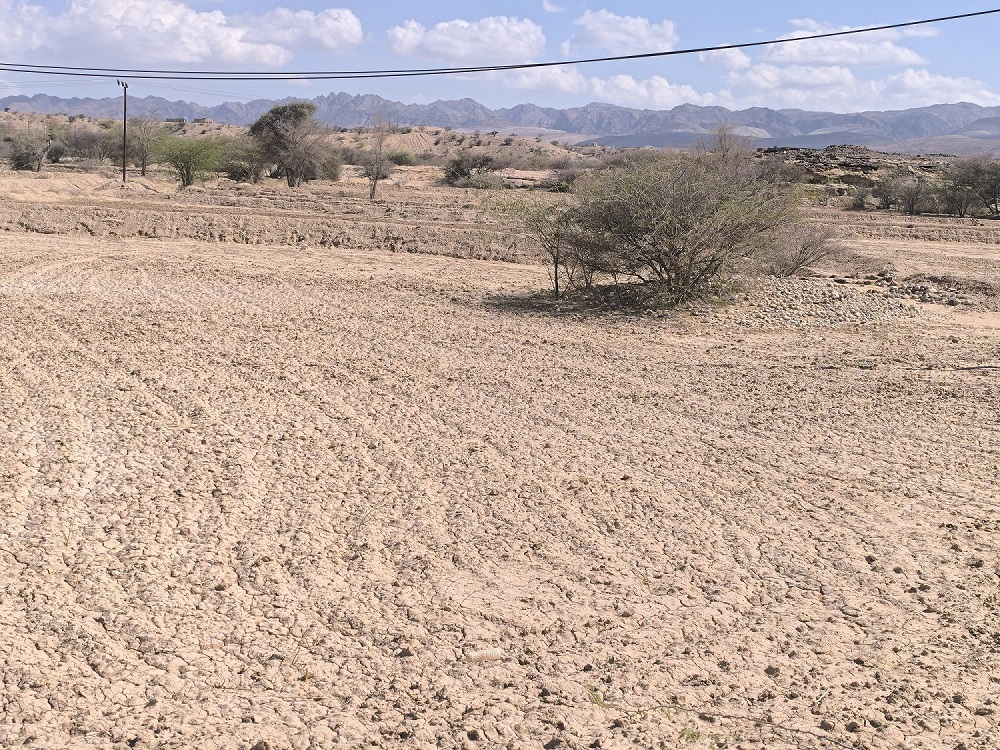
Effects of desertification in Habban district, Shabwa governorate, South Yemen, May 1, 2025 (South24 Center)
Loss of Land
The most prominent official warning regarding the rate of agricultural land loss in Yemen came from the Minister of Water and Environment, Tawfiq Al-Sharjabi, during his participation in the Conference of the Parties (COP16) held in Riyadh in December 2024. Al-Sharjabi stressed that "desertification is one of the biggest environmental crises facing Yemen", noting that the country loses between "3–5% of arable land annually due to climate change, grazing, deforestation, poor water resource management, and armed conflict”.
In the same context, Deputy Minister of Agriculture, Engineer Ahmed Al-Zamki, provided more specific figures of the impact on the agricultural sector. Speaking to ’South24 Center‘, Al-Zamki stated: "The percentage of agricultural land affected by desertification in Yemen has reached 17.5%, which represents an area of approximately 79,000 square kilometers. This poses a major challenge to the agricultural sector and food security in the country.”Effects of desertification in Habban, in Shabwa governorate, South Yemen, May 1, 2025 (South24 Center)
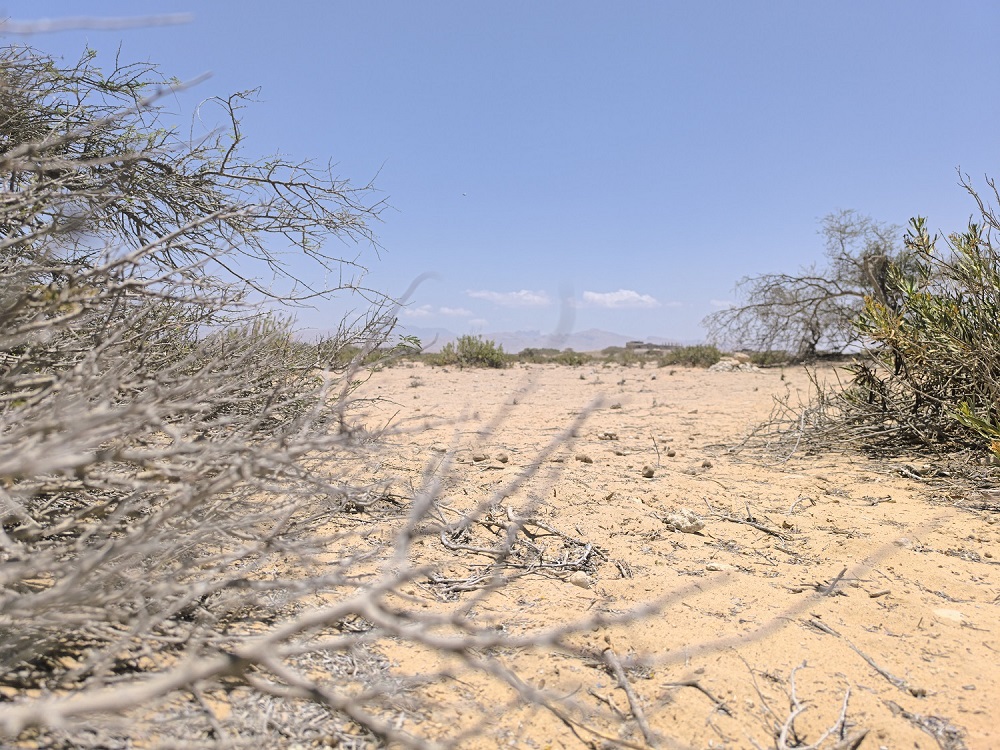
Effects of desertification in Habban, in Shabwa governorate, South Yemen, May 1, 2025 (South24 Center)
These figures align with global estimates indicating that the world loses about 100 million hectares of healthy and productive land each year. In Yemen’s case, data from a government study conducted by the Studies Sector of the Ministry of Planning and International Cooperation — with support from the United Nations and published in the Economic and Social Bulletin of Yemen (Issue 74, July 2022) — shows that the desertification crisis has reached alarming levels. The study estimates that 405,000 square kilometers of land are affected by desertification, accounting for over 71% of the country’s total area. Additionally, 15.9% of Yemen’s land is considered at risk of desertification.
This widespread degradation has catastrophic implications for the country’s food security. In a country where arable land is estimated at around 3.62 million hectares (representing around 7% of the total area), agriculture remains a vital source of livelihood for millions of Yemenis. As desertification increases, the food insecurity crisis affecting more than 16 million people continues to worsen, turning the soil crisis into a national emergency that threatens survival and stability.
Causes
The desertification crisis in Yemen does not stem from natural factors alone. It is the result of a complex interaction between harsh climatic conditions, unsustainable human activities, the direct and indirect effects of war, and the consequences of global climate change. This convergence makes desertification a multidimensional crisis that requires a comprehensive understanding to unravel its root causes.
Professor Omar Salem Al-Muhammadi, a professor of Urban Planning Geography and Geographic Information Systems (GIS) at Hadramout University, told ’South24 Center‘ that "the rate of land degradation in Yemen has accelerated significantly in recent years”, attributing this deterioration largely to "the direct and indirect effects of the war, and the increasing frequency and intensity of natural disasters such as cyclones and flash floods.”
Al-Muhammadi added that the causes also include "Yemen's naturally harsh climatic conditions and the overexploitation of natural resources". However, he placed emphasis on two key factors. The first is "global climate change, which leads to rising temperatures and shifts in rainfall patterns, thereby intensifying drought and directly contributing to the increased frequency and severity of extreme weather events."
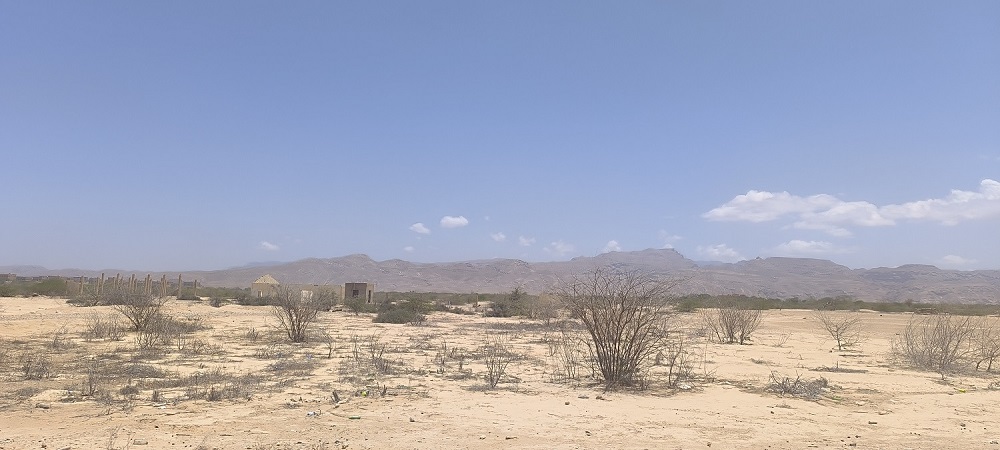
The effects of desertification in Habban, Shabwa governorate, South Yemen, May 1, 2025 (South24 Center)
Yemen is already witnessing clear signs of these effects, as temperatures have risen; and 2024 saw a shortage of rainfall followed by devastating floods that directly impacted agricultural activity and weakened the ability of local communities to adapt.
Deputy Minister of Agriculture, Engineer Ahmed Al-Zamki, confirmed this trend, saying: “Climate change directly contributes to the growing desertification due to rising temperatures beyond normal levels, as well as severe drought, and irregular and scarce rainfall on one hand, and the occurrence of floods and cyclones on the other.” He added: “These challenges have exacerbated in our country, which is classified as one of the water-scarce nations, as it relies primarily on rainfall to meet water needs in all sectors, especially agriculture, which consumes around 90% of the available water resources.”
Al-Zamki further explains that “our country is among the most vulnerable and the least prepared to face and adapt to climate change. It is also among the countries with little to no access to climate financing”, referring to the limited international support available to strengthen Yemen's resilience in the face of environmental crises.
The second factor highlighted by Al-Muhammadi relates to the ongoing war, which “continues to cast a catastrophic shadow over the environment through the direct destruction of agricultural lands and irrigation infrastructure, pollution of soil and water, the forced displacement of populations, and the obstruction of any institutional response efforts.” Al-Zamki agreed with this assessment, adding: “What has worsened these challenges is the continuation of the conflict, which has been ongoing for more than 10 years.”
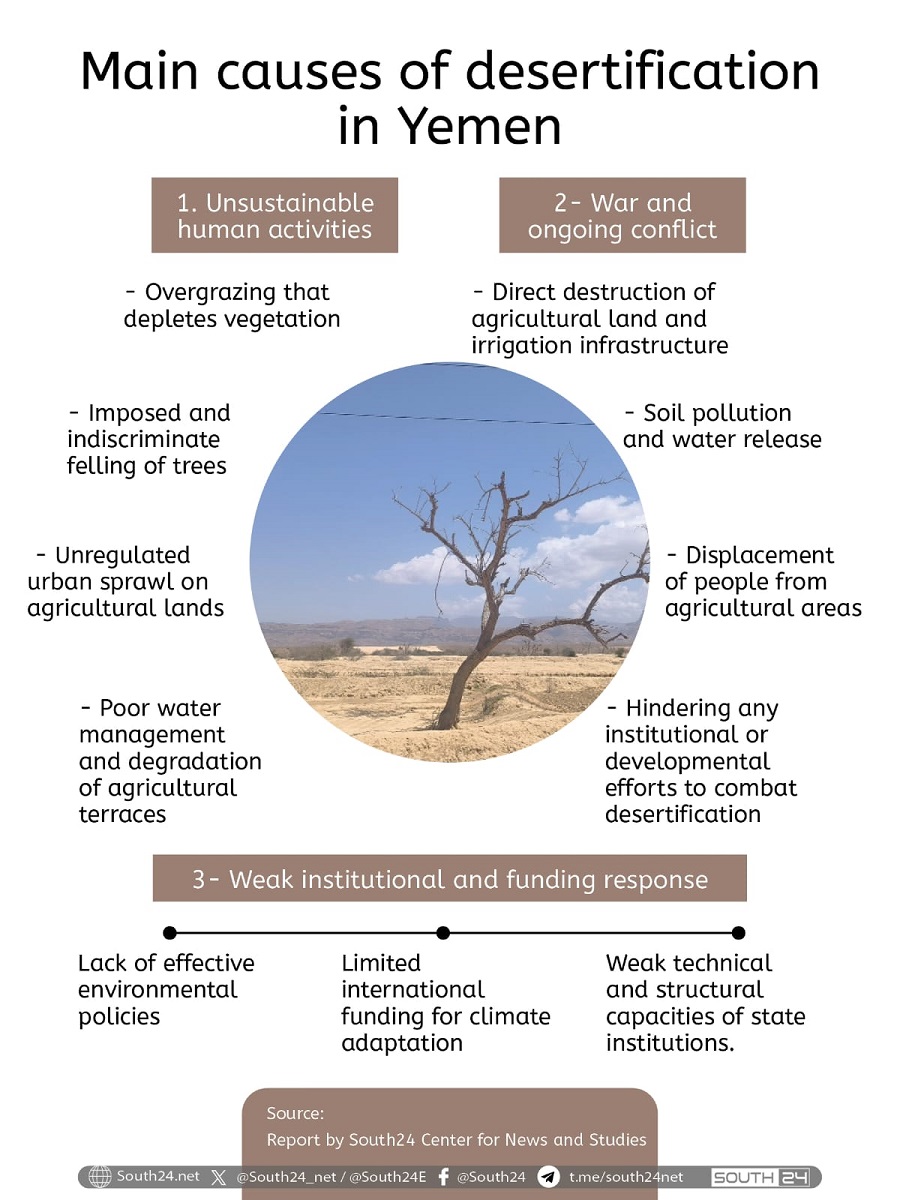
In addition to war and climate, unsustainable agricultural practices, such as overgrazing, excessive tree cutting, and the degradation of terraced farmland, are also deepening the crisis. A report issued by the United Nations Development Programme (UNDP) noted that Yemen is facing rising temperatures, changes in rainfall patterns, and an increase in weather-related disasters, all of which exacerbate land degradation and place additional strain on the country’s limited resources.
Effects
The worsening effects of desertification in Yemen are clearly manifested through distinct environmental and social indicators, reflecting an advanced state of degradation. Professor Omar Salem Al-Muhammadi explains that the signs of desertification have become "clearly visible". He listed them as follows, “a sharp decline in soil fertility, widespread degradation of vegetation cover, increasing encroachment by sand dunes, worsening water scarcity and deterioration of water quality, and a noticeable increase in dust and sandstorms.”
Environmental activist Zahra Khamis warns of the severe consequences of this phenomenon on local communities, considering it a direct threat to people's livelihoods and food security. Speaking to ’South24 Center‘, Khamis says: "Desertification strikes at the heart of farmers’ livelihoods. It causes drying up of agricultural lands and the depletion of vital water sources such as artesian wells and rivers. Even seasonal floodwaters have become scarce."
Khamis, who hails from Wadi Hajar district in Hadramout, explains that the ongoing degradation has "greatly reduced farmers’ ability to cultivate their land or achieve meaningful productivity, threatening both their food and economic security”. She adds, "We are facing a serious natural phenomenon, an environmental disaster no less severe than other natural calamities we have witnessed, such as Cyclone Chapala (in 2015), which caused massive soil erosion and the destruction of wells, crops, and trees.”
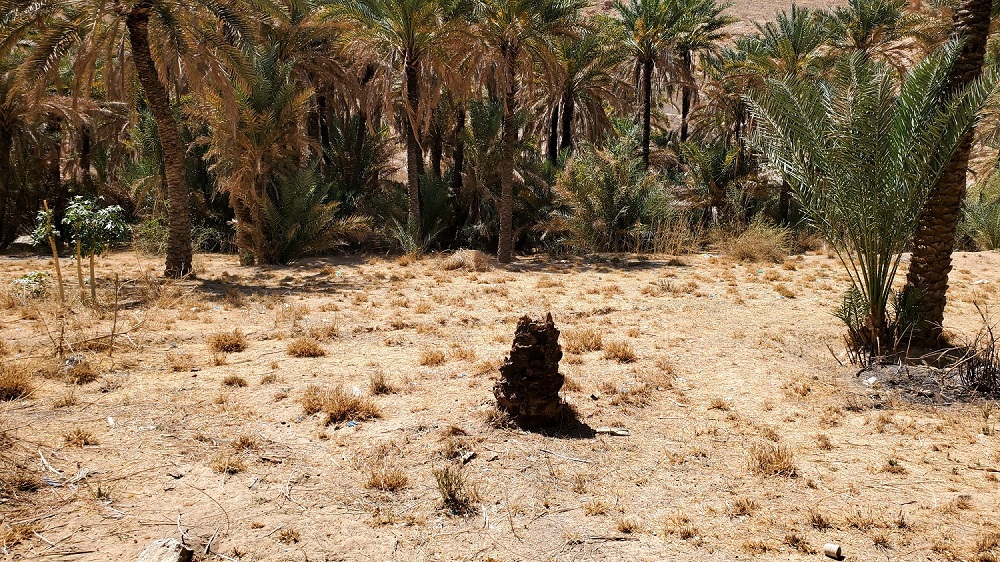
The effects of desertification and drought in Rehab, Dawan district, Hadramout governorate, South Yemen, May 1, 2025 (South24 Center)
Regarding the noticeable changes in the local environment, Khamis said: “The land and water have undergone drastic and alarming changes. Over the past years, we have observed how desertification has caused the erosion of the fertile topsoil, leaving farmlands degraded and incapable of supporting essential crops like bananas and palm trees. Restoring their fertility has become a major challenge.” She added: “As for water sources, they have either disappeared or declined sharply. Flash floods are no longer a blessing, but have become a destructive force that buries wells in sediment and renders them inoperative, worsening the water crisis.”
These consequences are vividly reflected in the testimonies of farmers on the ground. Standing in front of a barren patch of land in Wadi Al-Muhammadayn, west of Mukalla on the Hadramout coast, farmer Saida Bawadi, 47 years old, says, “Our land is no longer the one we once knew. Everything has changed. Wells have dried up, the soil has cracked, and many of our trees have died. Production has collapsed terribly, and we are living on the bare minimum.” She added: “Here in Wadi Al-Muhammadayn, we are suffering immensely. The drought has shown us no mercy, the rain is extremely scarce, and when it does come, it sometimes turns into floods that washes away what little remains of arable soil. This situation, which experts describe as ‘rapidly creeping desertification’, threatens our very existence as farmers.”
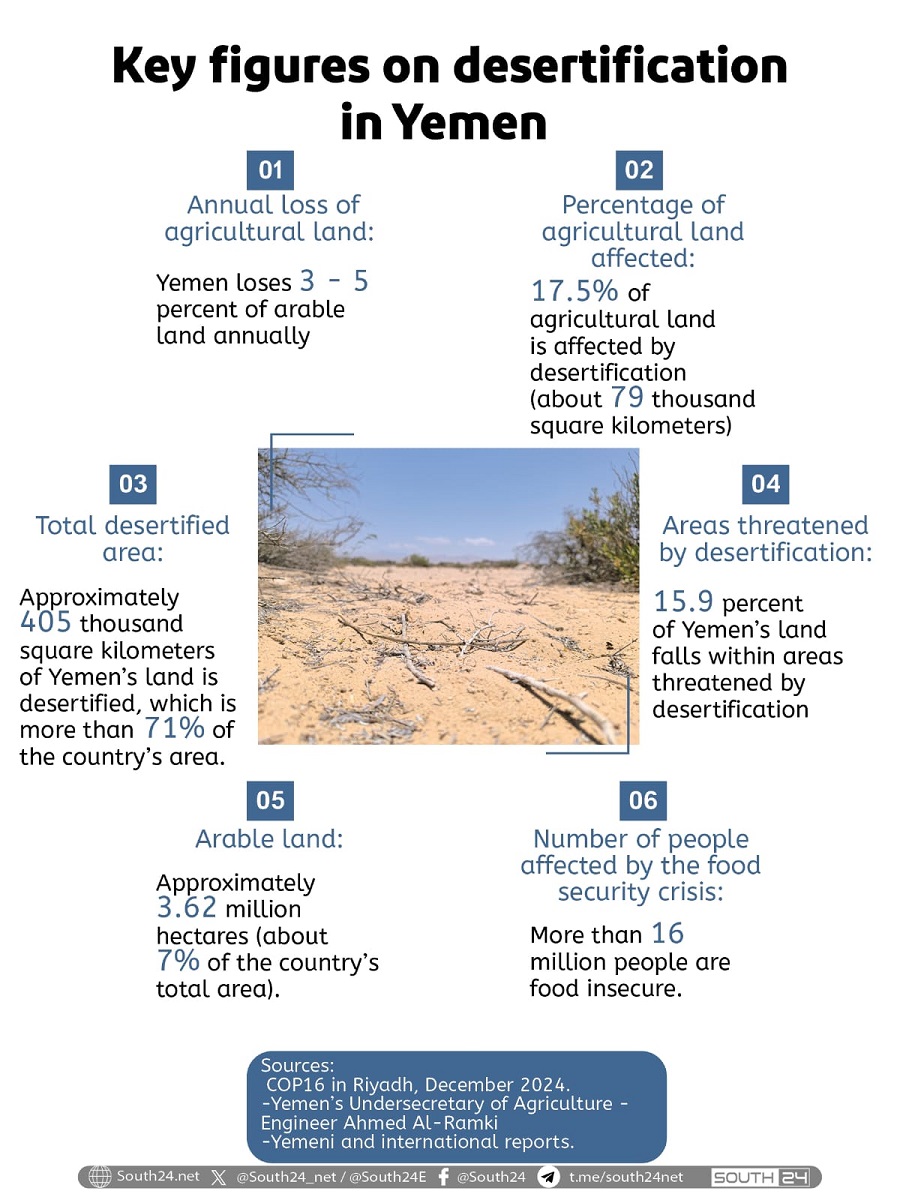
Bawadi explains their daily struggle, saying: "The deterioration of soil fertility and the loss of its vital elements is something we experience daily. We used to cultivate various types of crops, but today we struggle immensely to grow anything. We see the sand dunes approaching closer, and we feel the climate changing, with temperatures rising in an unprecedented way, and dust storms becoming more frequent. This is exactly what the exacerbation of water scarcity and the deterioration in its quality means."
In Dawan district, Salma Obeid, a 55-year-old farmer, recounts a similar experience, saying: "The land which I inherited from my husband, is now vanishing before my eyes. The output of my farm is frighteningly dwindling year after year.” She added: "The drought strikes harshly, and rain has become very rare. This scarcity of water has turned our once fertile clay soil into hard, poor soil." She points out that the soil has lost its vitality, saying: "We used to grow corn, sesame, and some vegetables, but now the seeds either don’t germinate at all, or the plants grow weak and stunted."
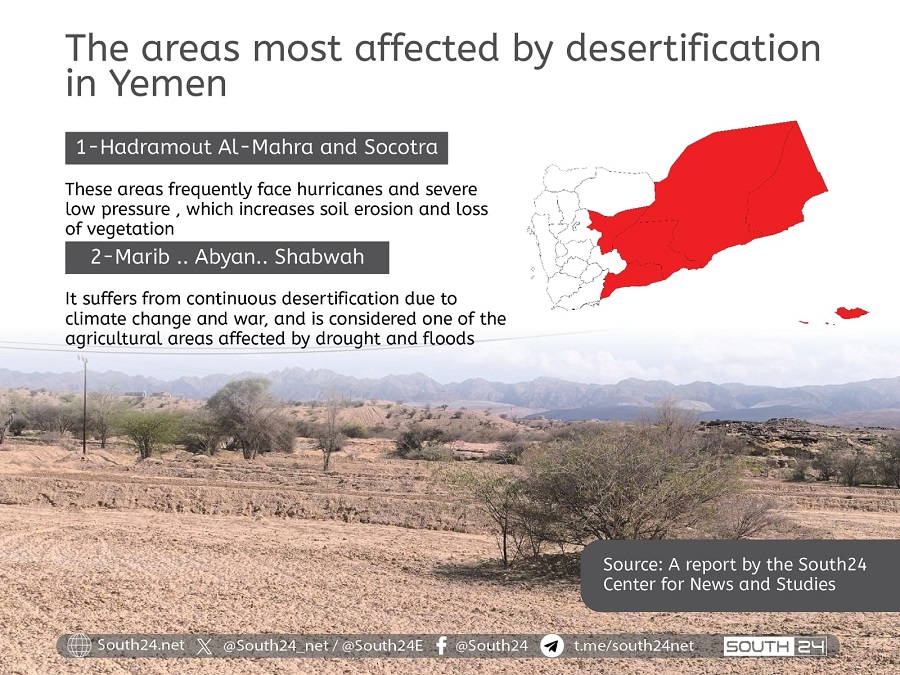
In a bitter tone, Obeid continued: "With each passing day, the situation gets worse. I keep thinking about how to deal with land that has turned barren. Losing our land means losing everything. No one supports us. We are not even on the margins of attention from the organizations or the state, at the very least."
For his part, Professor Al-Muhammadi explains that dry and semi-arid marginal areas, traditional grazing lands, and agricultural zones that rely on seasonal rains are the most vulnerable and affected. He pointed to “the eastern regions, specifically the governorates of Hadramout, Socotra, and Al-Mahra, which now face direct and frequent exposure to violent cyclones and low-pressure systems.” He added that the governorates of Marib, Abyan, and Shabwa are also among the areas experiencing ongoing desertification. He emphasized that this phenomenon is not limited to Yemen but is part of a broader challenge affecting the Arab region as a whole.
Responses
Despite the growing threat of desertification in Yemen, efforts to combat it continue to face enormous challenges. These include the ongoing conflict, political and economic instability, alongside limited resources, and poor technical and institutional capacities. According to the classification by the Ministry of Planning and International Cooperation, Yemen ranks 30th among the most vulnerable countries and 17th among those least capable of adapting to the effects of climate change, reflecting the fragility of the national response to this environmental crisis.
In this context, Deputy Minister of Agriculture, Engineer Ahmed Al-Zamaki, notes that the ministry is adopting a range of measures to combat desertification, including biological and mechanical methods. He emphasized that among the key solutions being implemented are afforestation programs, expanding the use of greenhouse agriculture, and promotion of intensive farming techniques to maximize the use of limited resources. He also highlighted the adoption of nature-based solutions, such as Agrosilvopastoral systems (integrating agriculture, forestry, and grazing) and Agroforestry systems, in addition to sand dune stabilization programs through tree planting and the creation of green belts.
Despite these efforts, Professor Omar Al-Muhammadi believes that the scale of the challenge requires a more comprehensive and integrated approach. He stressed the need to adopt practical strategies focused on strictly preserving the remaining vegetation cover and water resources. He proposed adoption of efficient water management technologies, support for sustainable agricultural practices, implementation of land rehabilitation projects, and intensifying environmental awareness programs, while ensuring the active involvement of local communities.
Al-Muhammadi believes that it is essential to integrate humanitarian and disaster relief efforts with desertification control plans and programs, and to direct part of these efforts toward protecting the less-affected areas in order to prevent the further spread of land degradation.
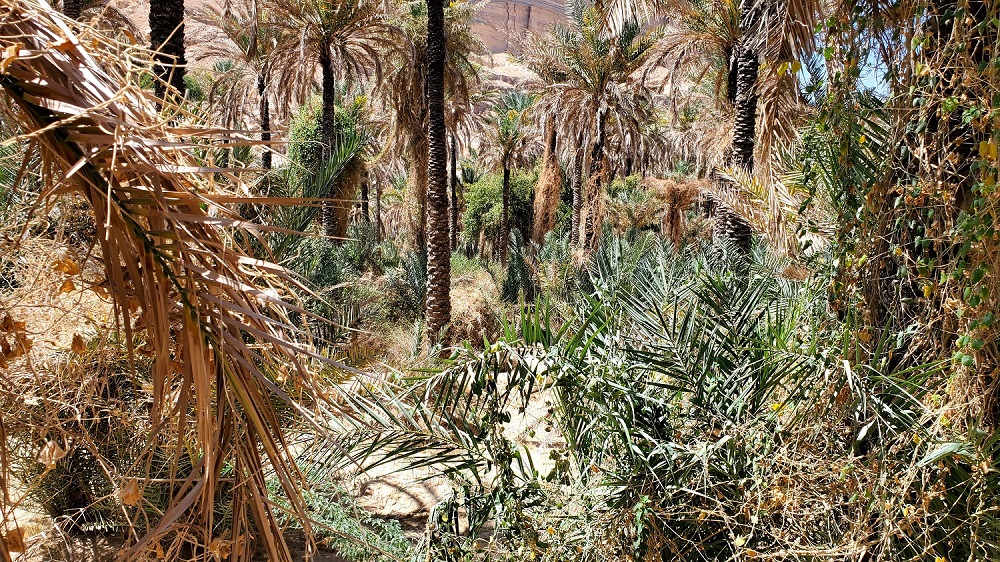
The effects of desertification and drought in Rehab, Dawan district, Hadramout governorate, South Yemen, May 1, 2025 (South24 Center)
This approach resonates with affected farmers on the ground. Saeeda Bawadi says: “We are in desperate need of real support -- projects that bring life back to us and provide sustainable solutions.” Salma Obeid appeals to the relevant authorities and organizations, saying: “We do not want to abandon our land. We call on anyone who can help to see our suffering. We need support in the form of modern agricultural technologies, and projects for soil rehabilitation and improved irrigation.”
Environmental activist Zahra Khamis explains that there are urgent needs that must be addressed to confront the crisis, including the construction of effective water barriers and dams to harvest and preserve the floodwaters. She adds: “We also need to build bridges, but not just traditional ones. These should be intelligently designed structures that help collect water in designated areas for longer periods and reduce the erosion of topsoil.”
Khamis points to a successful model implemented in Jazul in Wadi Hajar, where a bridge was built with funding from the Benaa Foundation for Development and international donors, in cooperation with the local authorities. She stresses that “this model should be replicated in other affected areas.”
Recommendations
On December 10, 2024, the United Nations Development Programme (UNDP) issued a set of recommendations to address the desertification crisis in Yemen, emphasizing on the need for comprehensive and sustainable solutions. The recommendations included prioritizing a peaceful resolution to the conflict, developing environmental and resource-related databases, and improving the regulation and efficiency of agricultural water use. It also called for the implementation of agricultural practices that help reduce soil erosion, investing in infrastructure for climate forecasting, and support for the human, social, and economic development of the most vulnerable groups.
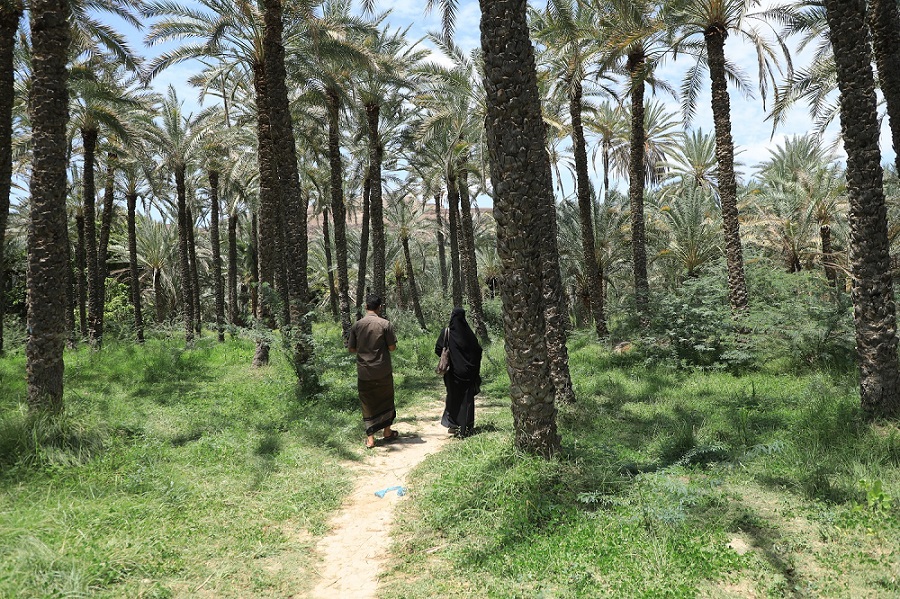
A date palm farm in Wadi Hajar District, Hadramout Governorate – August 27, 2024 (South24 Center)
Professor Omar Al-Muhammadi reaffirmed the urgent need for coordinated efforts at all levels to confront this existential environmental challenge. He stressed that protecting the environment in Yemen and rehabilitating degraded lands is not a choice, but a necessary investment in the future of Yemen, its food and water security, and a guarantee for the sustainability of its natural resources for the benefit of future generations.
This call echoes the sentiments expressed by farmer Salma Obeid, who summed up the depth of the crisis, and the hope of overcoming it, in simple words, saying: “Saving what remains of our farmland is not just saving us as farmers, it is an investment in Yemen’s future and its food security.”
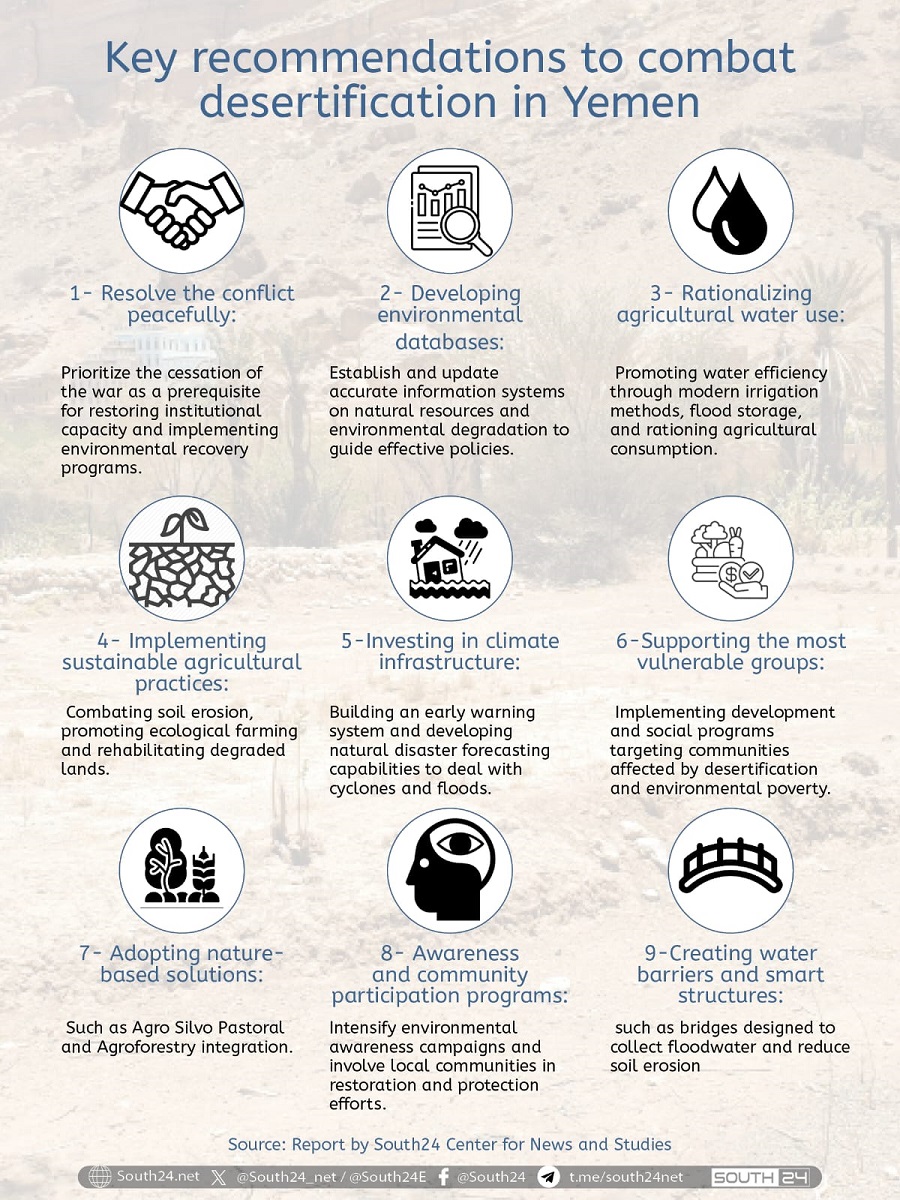
On a broader scale, the desertification crisis is not limited to Yemen alone, but is part of a serious regional challenge. According to a study by the Arab Monetary Fund, several Arab countries, such as Bahrain, Kuwait, the UAE, and Qatar, are entirely desertified. The rate of desertification in ten other countries, including Yemen, Saudi Arabia, Egypt, Algeria, Jordan, and Morocco, range between 60% and 98%. This regional reality places an added responsibility on governments and international organizations to launch more effective collective responses.
Journalist at South24 Center for News and Studies
Note: This is a translated version of the original text published in Arabic on June 19,2025
This report is part of a project funded by the Urgent Action Fund, which aims to highlight climate and environmental issues, as well as issues affecting women and people with disabilities.
Previous article